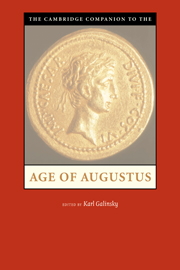Book contents
- Frontmatter
- Introduction
- Part I Political History
- Part II Intellectual and Social Developments
- Part III The Emperor's Impact
- Part IV Art and the City
- 9 Semblance and Storytelling in Augustan Rome
- 10 Making Rome A World City
- 11 Augustan Domestic Interior: Propaganda or Fashion?
- Part V Augustan Literature
- Part VI Epilogue as Prologue
- Select Bibliography and Works Cited
- Index
11 - Augustan Domestic Interior: Propaganda or Fashion?
from Part IV - Art and the City
Published online by Cambridge University Press: 28 March 2007
- Frontmatter
- Introduction
- Part I Political History
- Part II Intellectual and Social Developments
- Part III The Emperor's Impact
- Part IV Art and the City
- 9 Semblance and Storytelling in Augustan Rome
- 10 Making Rome A World City
- 11 Augustan Domestic Interior: Propaganda or Fashion?
- Part V Augustan Literature
- Part VI Epilogue as Prologue
- Select Bibliography and Works Cited
- Index
Summary
We have ample documentation, both from archaeological finds and in ancient texts, for interior decoration in the age of Augustus. In Rome itself we have considerable remains of the wall and ceiling painting from Augustus' own house on the Palatine, as well as the painted and stucco decorations from a villa that may have belonged to Agrippa and Julia. At Boscotrecase, near Pompeii, archaeologists excavated several rooms of a villa that may have belonged to Agrippa's son, Postumus. Vitruvius, an architect who dedicated his treatise to the Emperor around 20 B.C., describes the established style of wall painting and then goes on to complain about a new style coming into vogue at the moment. Pliny the Elder discusses the work of a certain Studius active during the Augustan age, crediting him with inventing a special kind of landscape painting.
Art historians and archaeologists have studied these Augustan monuments and texts with great intensity and considerable imagination. The resulting narratives make a broad range of claims. The earlier accounts focussed on chronology (Mau 1882; Beyen 1938-1960); in Mau's famous dating scheme of the Four Styles of Romano-Campanian painting, the paintings from Augustus' house on the Palatine (circa 30 B.C.) mark the midpoint of the last phase of the Second Style (40-20 B.C.), and those of the villa of Agrippa and Julia (dubbed the Villa under the Farnesina) mark the transition from the Second to the Third Style (about 20 B.C.). The Villa at Boscotrecase then serves as the finest example of early Third Style painting (15-1 B.C.).
- Type
- Chapter
- Information
- The Cambridge Companion to the Age of Augustus , pp. 264 - 278Publisher: Cambridge University PressPrint publication year: 2005
- 5
- Cited by

